Association of Weekly Suicide Rates with Temperature Anomalies in Two Different Climate Types
Abstract
:1. Introduction
2. Materials and Methods
2.1. Suicide Data
- data through intervention or interaction with the individual, or
- identifiable private information.
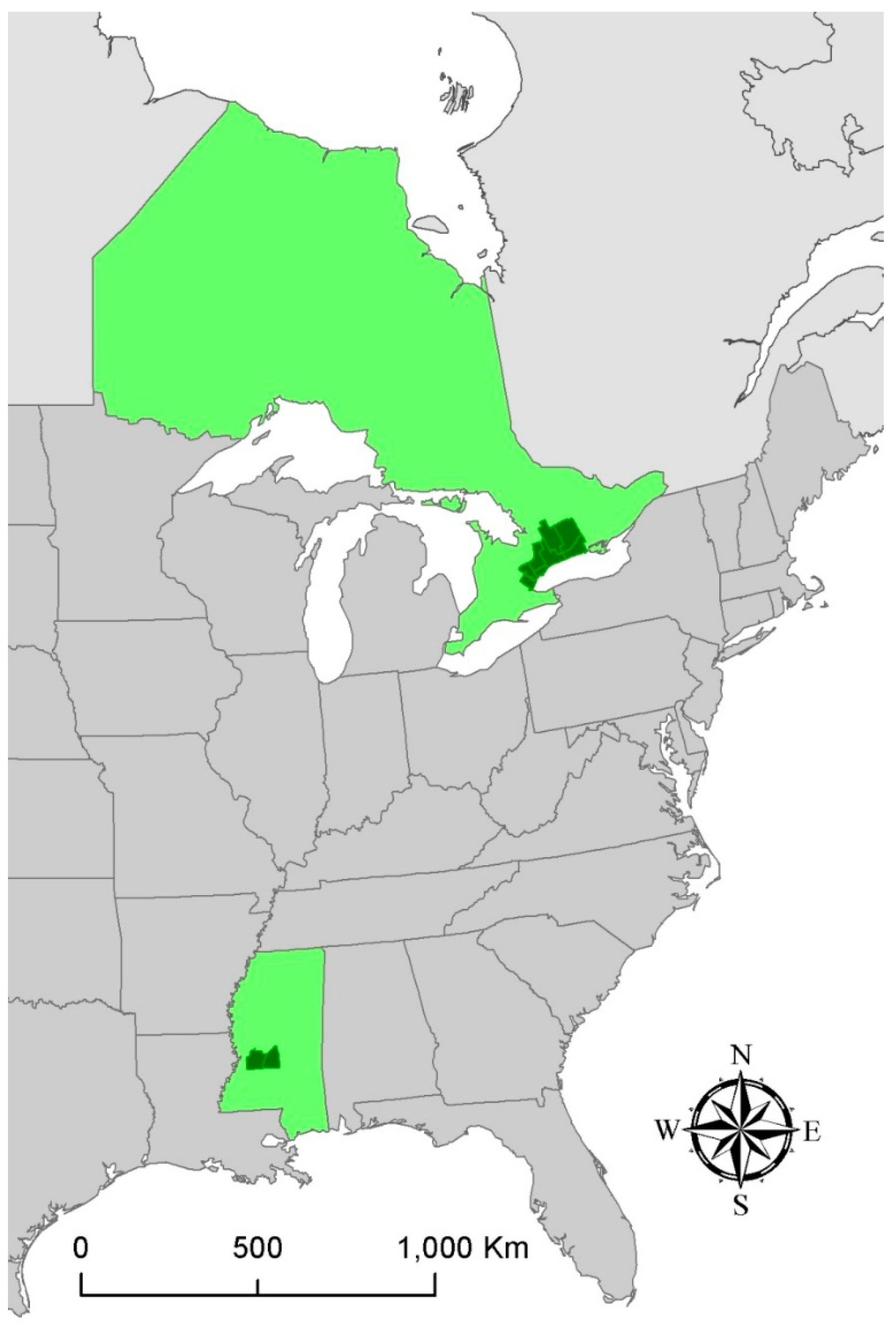
2.2. Meteorological Data
2.3. Weekly Anomalies
2.4. Distributed Lag Nonlinear Model
3. Results
3.1. Monthly Average Anomaly Differences for Toronto

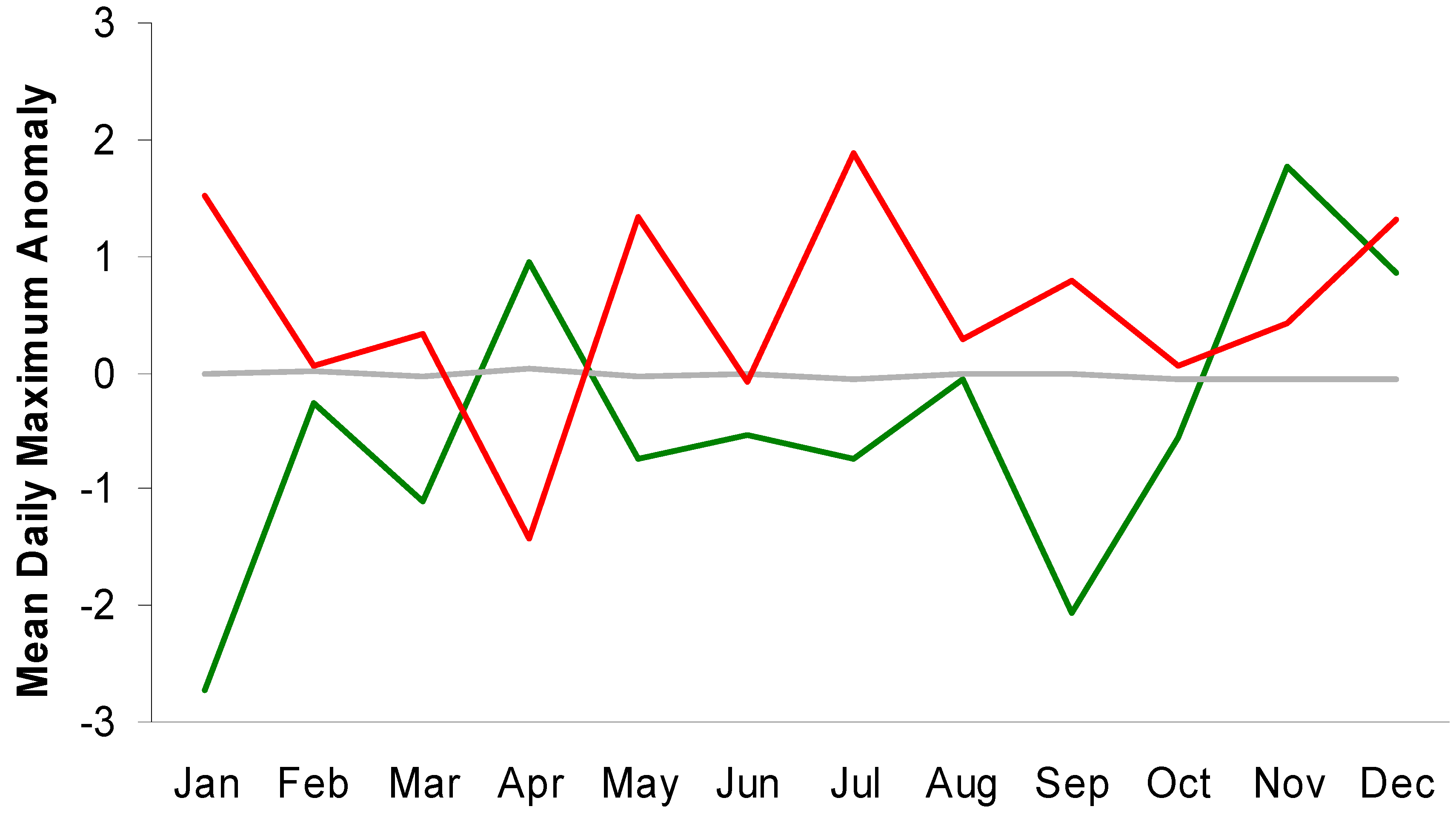
3.2. Toronto Scatterplot Anomaly Categories
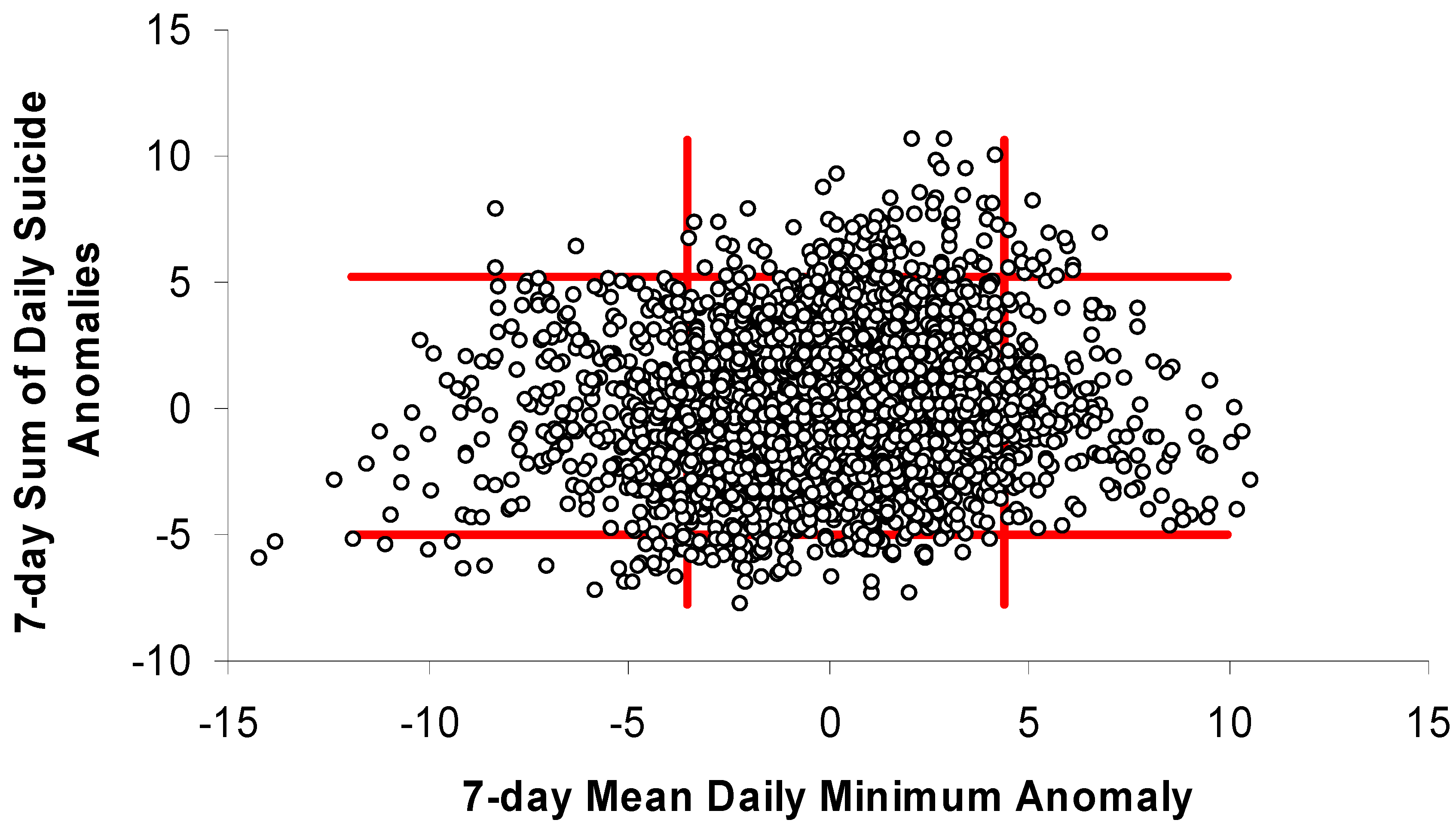
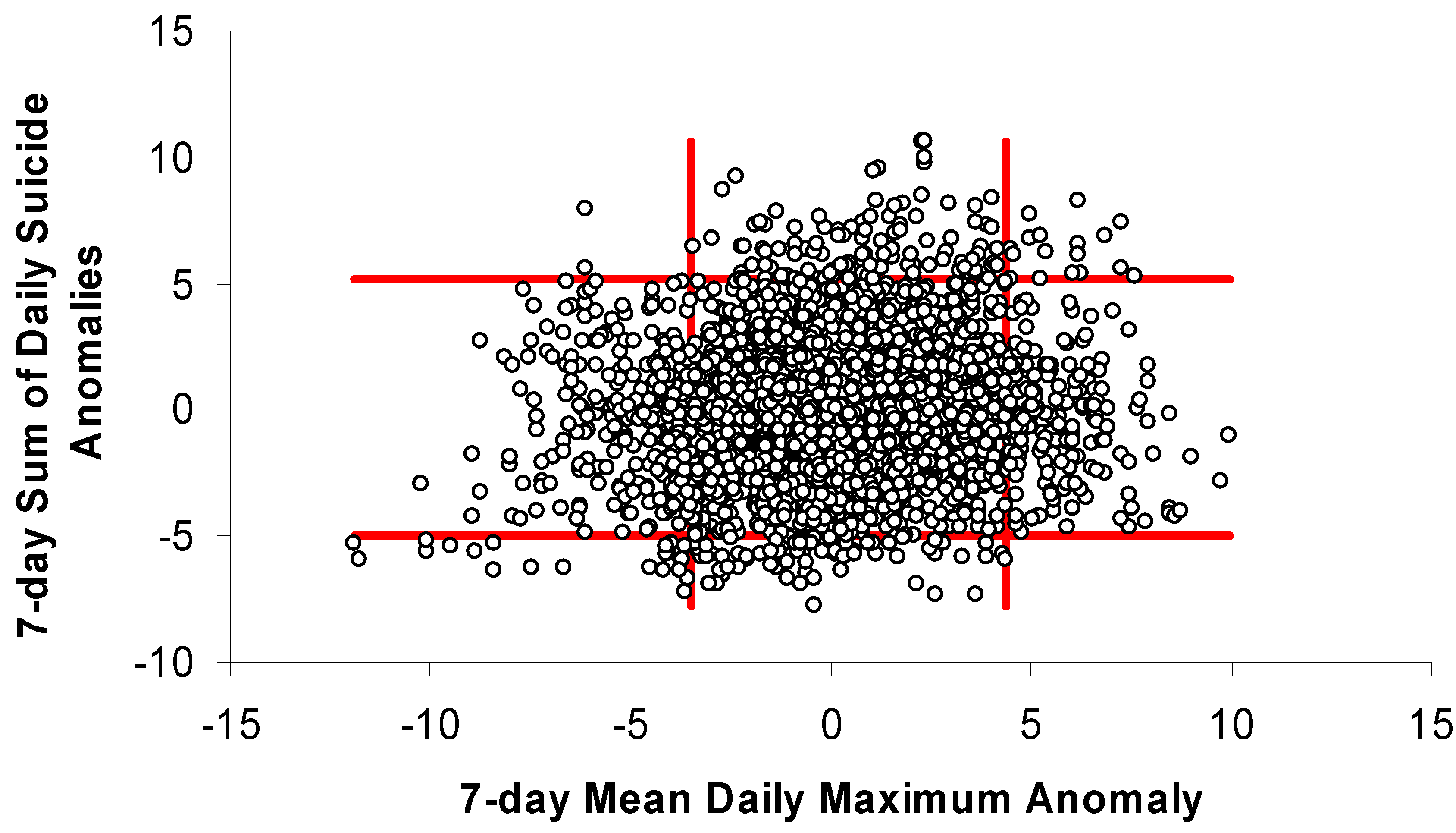
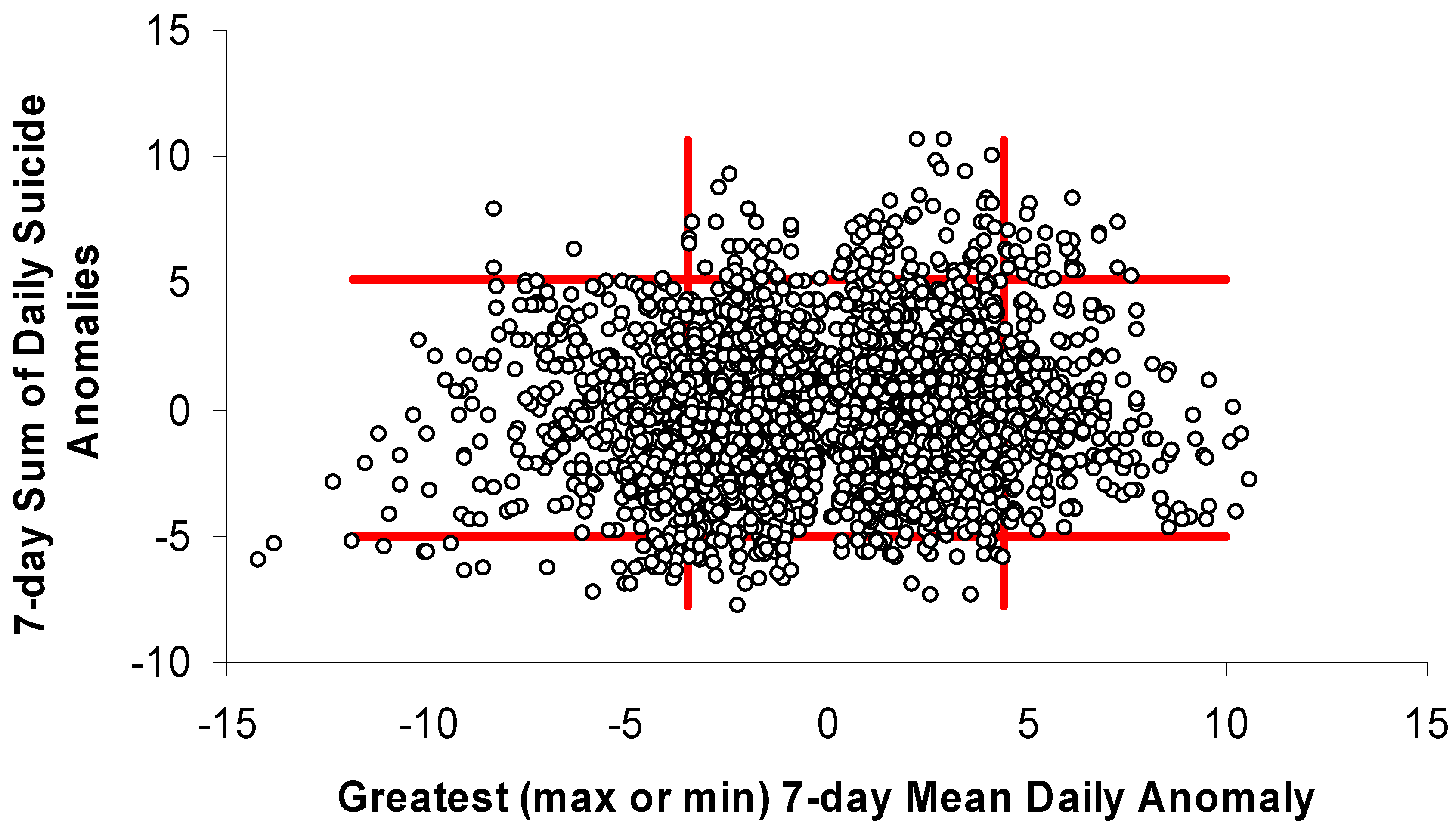
| Suicide Anomalies | Daily Minimum Temperatures | Daily Maximum Temperatures | Greatest Absolute Temperature Anomaly | ||||||||
|---|---|---|---|---|---|---|---|---|---|---|---|
| Cool | “Normal” | Warm | Cool | “Normal” | Warm | Cool | “Normal” | Warm | |||
| Total Days for Each Combination of Suicide and Temperature Anomalies | |||||||||||
| High | 3 | 98 | 18 | 2 | 102 | 15 | 3 | 89 | 27 | ||
| “Normal” | 326 | 2183 | 222 | 255 | 2300 | 176 | 387 | 2089 | 255 | ||
| Low | 27 | 69 | 0 | 22 | 74 | 0 | 31 | 65 | 0 | ||
| Combinations as Percentages of Days in Each Temperature Anomaly Category | |||||||||||
| High | 0.8 | 4.2 | 7.5 | 0.7 | 4.1 | 7.9 | 0.7 | 4.0 | 9.6 | ||
| “Normal” | 91.6 | 92.9 | 92.5 | 91.4 | 92.9 | 92.1 | 91.9 | 93.1 | 90.4 | ||
| Low | 7.6 | 2.9 | 0.0 | 7.9 | 3.0 | 0.0 | 7.4 | 2.9 | 0.0 | ||
3.3. Jackson, Mississippi Comparison
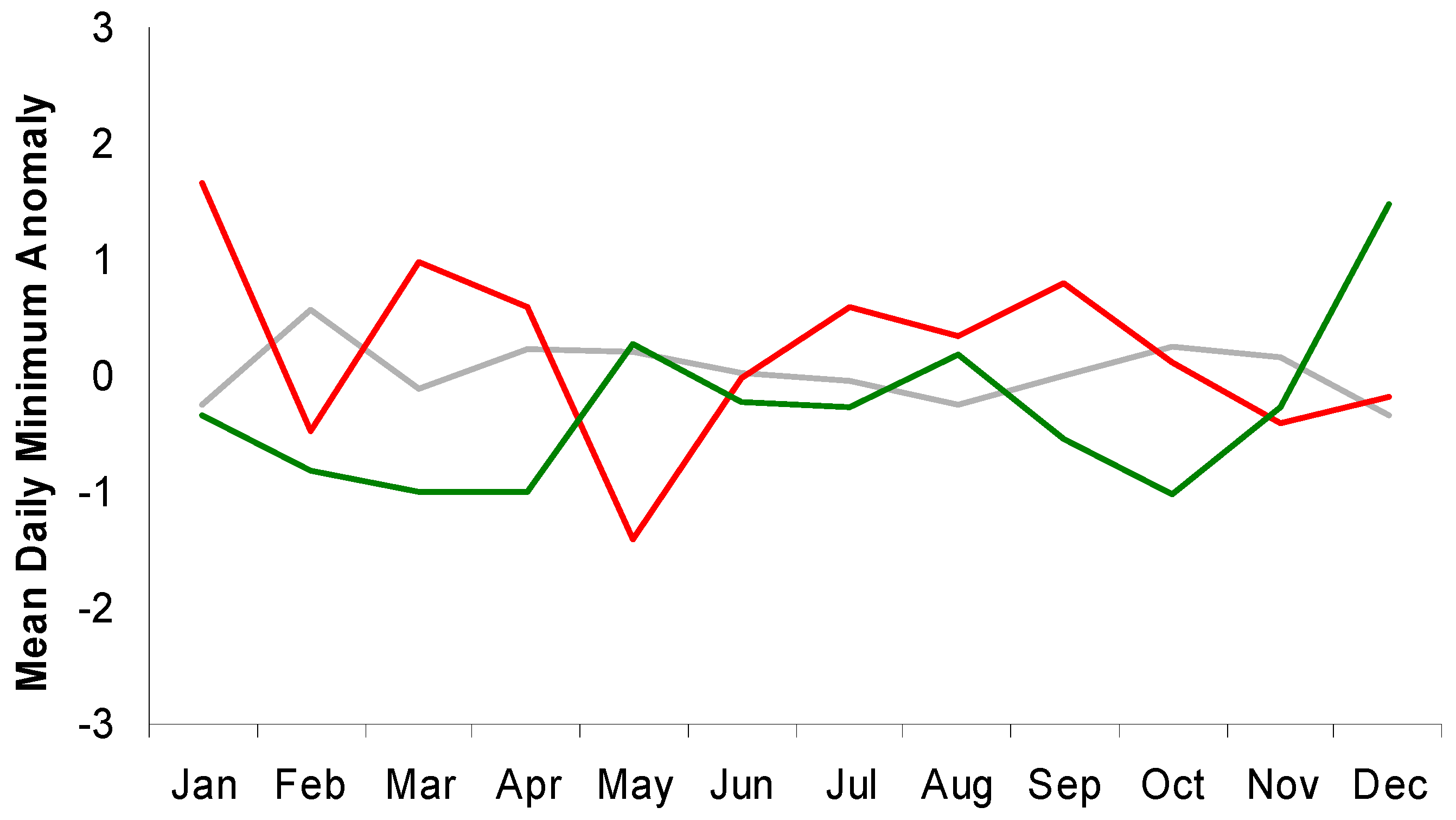
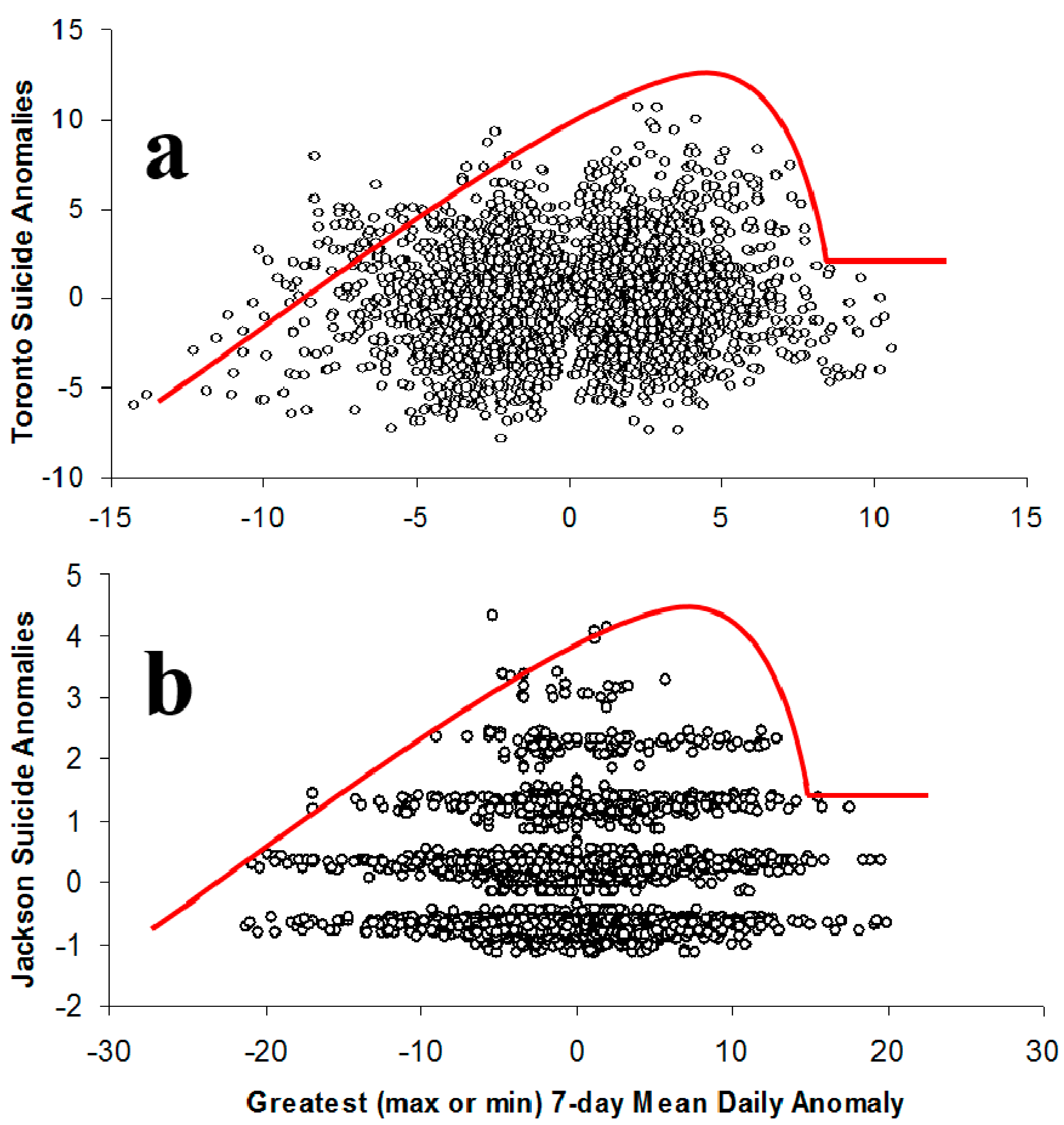
3.4. DLNM Results
| Lag Poly | 3-Day Lag | 4-Day Lag | 5-Day Lag | 6-Day Lag | ||||
|---|---|---|---|---|---|---|---|---|
| df | Temperature Spline df | AIC | Temperature Spline df | AIC | Temperature Spline df | AIC | Temperature Spline df | AIC |
| 2 | 3 | 24,742 | 3 | 24,655 | 3 | 24,582 | 3 | 24,515 |
| 2 | 4 | 24,743 | 4 | 24,657 | 4 | 24,585 | 4 | 24,514 |
| 2 | 5 | 24,747 | 5 | 24,662 | 5 | 24,589 | 5 | 24,518 |
| 2 | 6 | 24,749 | 6 | 24,667 | 6 | 24,593 | 6 | 24,522 |
| 2 | 7 | 24,754 | 7 | 24,671 | 7 | 24,599 | 7 | 24,526 |
| 2 | 8 | 24,756 | 8 | 24,676 | 8 | 24,601 | 8 | 24,528 |
| 3 | 3 | 24,746 | 3 | 24,660 | 3 | 24,588 | 3 | 24,521 |
| 3 | 4 | 24,748 | 4 | 24,659 | 4 | 24,592 | 4 | 24,522 |
| 3 | 5 | 24,753 | 5 | 24,666 | 5 | 24,595 | 5 | 24,529 |
| 3 | 6 | 24,751 | 6 | 24,672 | 6 | 24,602 | 6 | 24,534 |
| 3 | 7 | 24,755 | 7 | 24,676 | 7 | 24,610 | 7 | 24,539 |
| 3 | 8 | 24,757 | 8 | 24,679 | 8 | 24,611 | 8 | 24,544 |
| 4 | na | na | 3 | 24,665 | 3 | 24,592 | 3 | 24,527 |
| 4 | na | na | 4 | 24,666 | 4 | 24,594 | 4 | 24,525 |
| 4 | na | na | 5 | 24,673 | 5 | 24,598 | 5 | 24,532 |
| 4 | na | na | 6 | 24,672 | 6 | 24,607 | 6 | 24,539 |
| 4 | na | na | 7 | 24,675 | 7 | 24,612 | 7 | 24,546 |
| 4 | na | na | 8 | 24,679 | 8 | 24,614 | 8 | 24,549 |
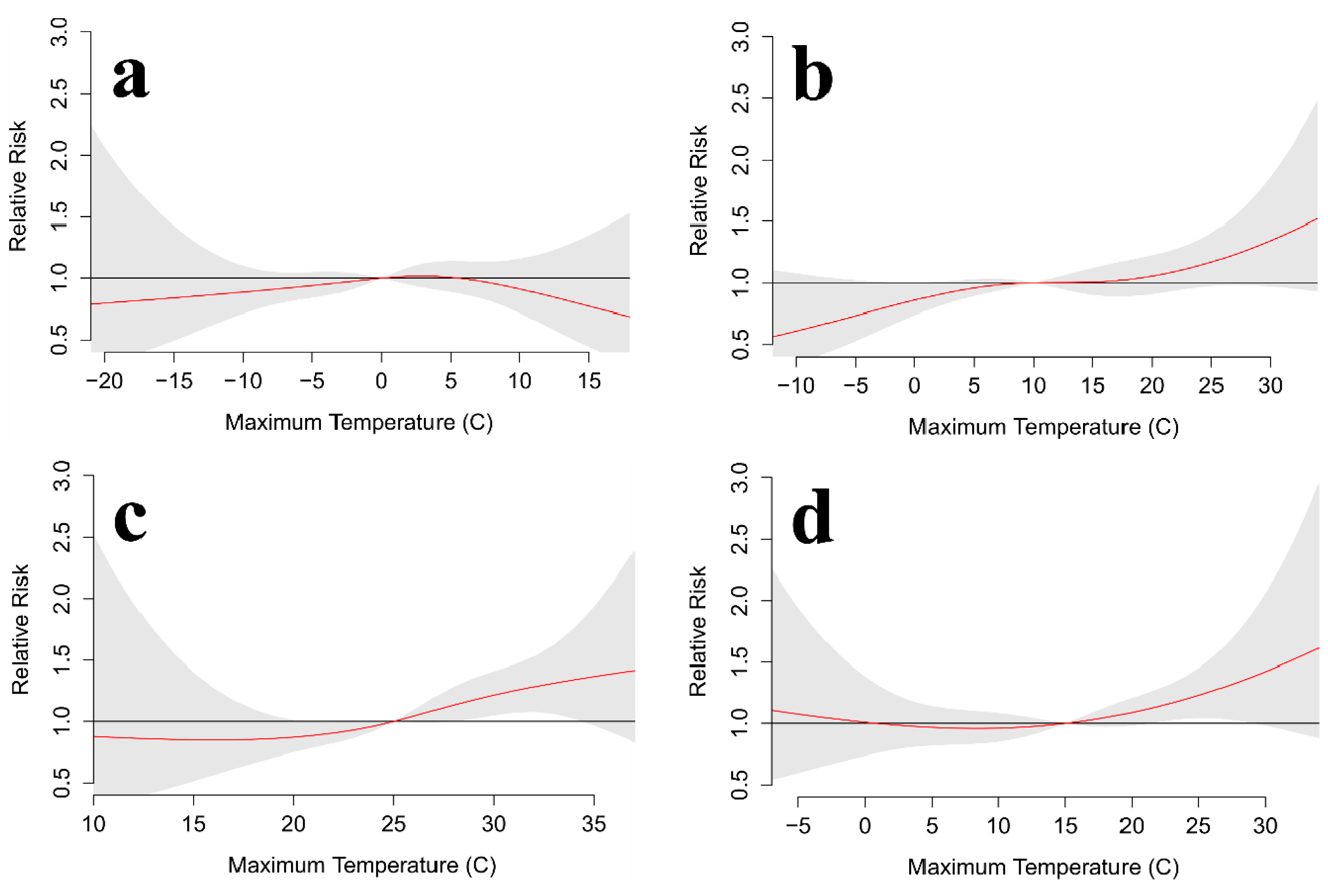
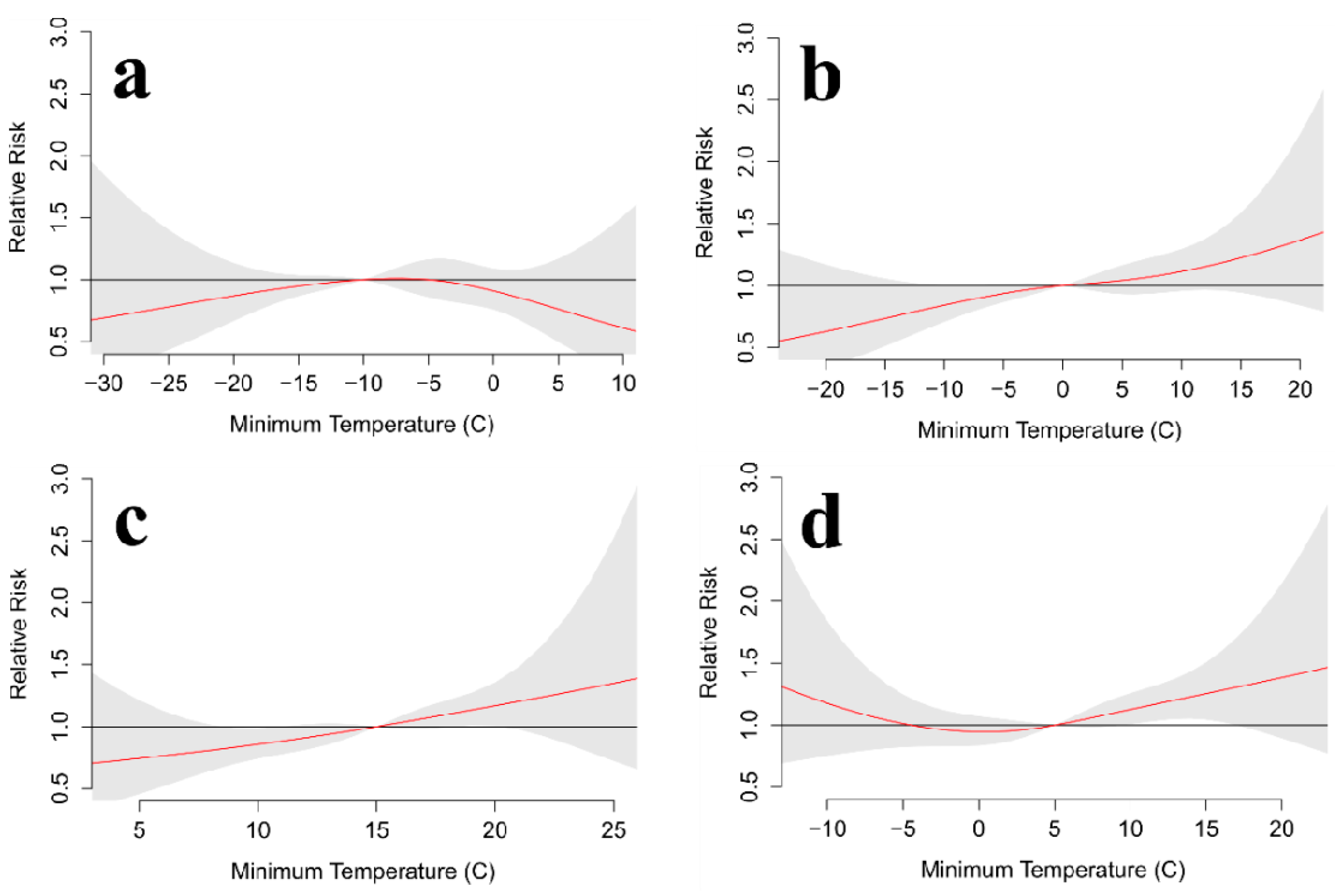
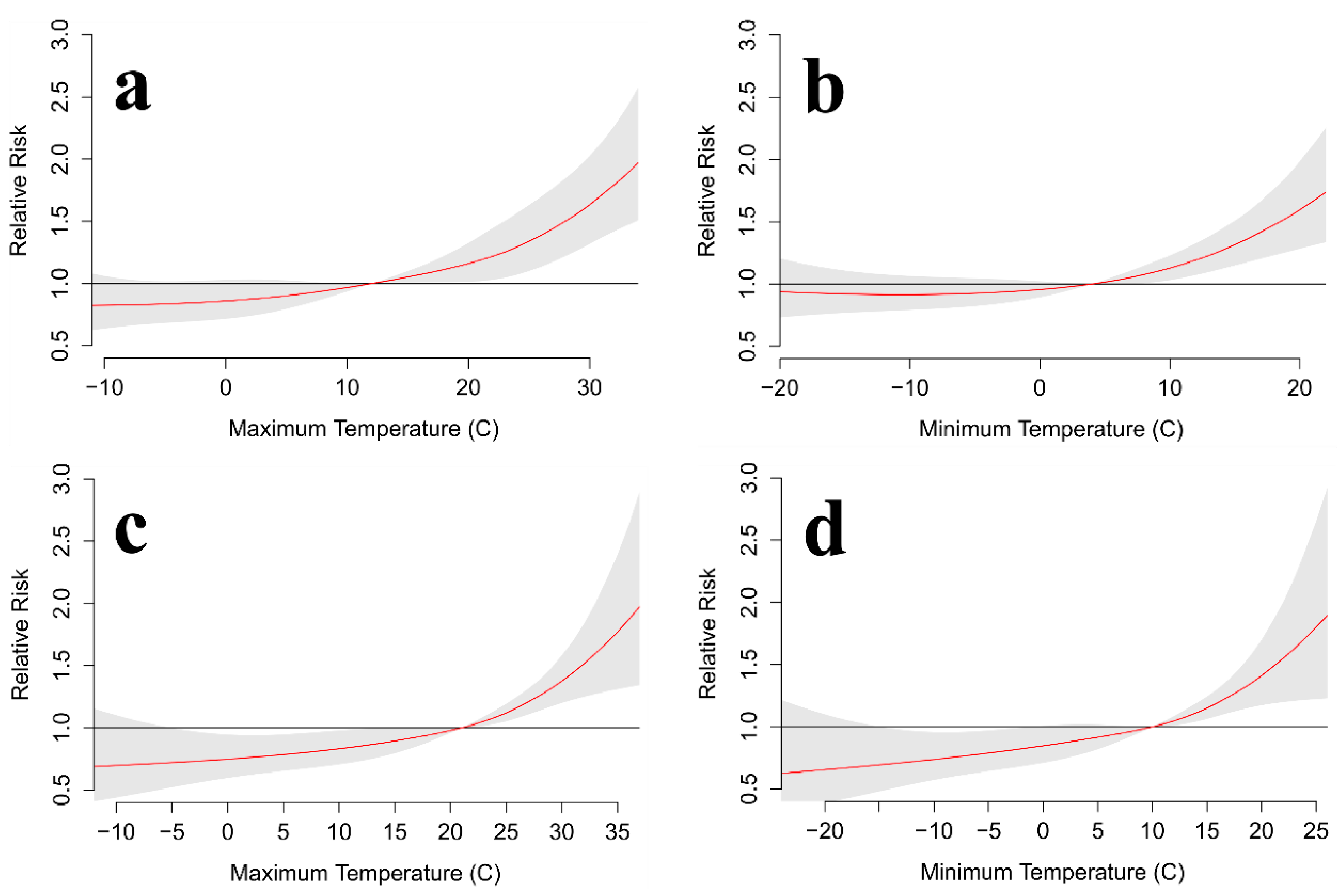

4. Discussion
5. Conclusions
Acknowledgements
Author Contributions
Conflicts of Interest
References
- WHO. Suicide huge but preventable public health problem, says who. In World Health Organization News Release; WHO: Geneva, Switzerland, 2004. [Google Scholar]
- Cooper, P.N.; Milroy, C.M. The coroner’s system and underreporting of suicide. Med. Sci. Law 1995, 35, 319–326. [Google Scholar] [PubMed]
- Graham, A.; Resser, J.; Scuderi, C.; Zubrick, S.; Smith, M.; Turley, B. Suicide: An Australian psychological society discussion paper. Aust. Psychol. 2000, 35, 1–28. [Google Scholar] [CrossRef]
- Yip, P.S.F.; Yam, C.H.; Chau, P.H. A re-visit on seasonal variations in suicides in the Hong Kong Special Administrative Region (HKSAR). Acta Psychiatr. Scand. 2001, 103, 315–316. [Google Scholar] [CrossRef]
- Rockett, I.R.H.; Regier, M.D.; Kapusta, N.D.; Coben, J.H.; Miller, T.R.; Hanzlick, R.L.; Todd, K.H.; Sattin, R.W.; Kennedy, L.W.; Kleinig, J.; et al. Leading causes of unintentional and intentional injury mortality: United States, 2000–2009. Am. J. Public Health 2012, 102, e84–e92. [Google Scholar] [CrossRef]
- CDC. Suicide among adults aged 35–64 years—United States, 1999–2010. Morb. Mortal. Wkly Rep. 1999, 62, 321–325. [Google Scholar]
- Clayton, D.; Barcel, A. The cost of suicide mortality in new brunswick, 1996. Chronic Dis. Can. 1999, 20, 89–95. [Google Scholar] [PubMed]
- Mościcki, E.K. Identification of suicide risk factors using epidemiologic studies. Psychiatr. Clin. North Am. 1997, 20, 499–517. [Google Scholar] [CrossRef] [PubMed]
- Deisenhammer, E.A. Weather and suicide: The present state of knowledge on the association of meteorological factors with suicidal behaviour. Acta Psychiatr. Scand. 2003, 108, 402–409. [Google Scholar] [CrossRef] [PubMed]
- Ruuhela, R.; Hiltunen, L.; Venäläinen, A.; Pirinen, P.; Partonen, T. Climate impact on suicide rates in finland from 1971 to 2003. Int. J. Biometeorol. 2009, 53, 167–175. [Google Scholar] [CrossRef]
- Hansen, J.W.; Hodges, A.W.; Jones, J.W. Enso influences on agriculture in the southeastern United States. J. Clim. 1998, 11, 404–411. [Google Scholar] [CrossRef]
- Dixon, P.G.; McDonald, A.N.; Scheitlin, K.N.; Stapleton, J.E.; Allen, J.S.; Carter, W.M.; Holley, M.R.; Inman, D.D.; Roberts, J.B. Effects of temperature variation on suicide in five U.S. Counties, 1991–2001. Int. J. Biometeorol. 2007, 51, 395–403. [Google Scholar] [CrossRef] [PubMed]
- Chiu, L.P.W. Do weather, day of the week, and address affect the rate of attempted suicide in Hong Kong? Soc. Psychiatry Psychiatr. Epidemiol. 1988, 23, 229–235. [Google Scholar] [CrossRef]
- Dixon, K.W.; Shulman, M.D. A statistical investigation into the relationship between meteorological parameters and suicide. Int. J. Biometeorol. 1983, 27, 93–105. [Google Scholar] [CrossRef] [PubMed]
- Pokorny, A.D. Suicide and weather. Arch. Environ. Health 1966, 13, 225–256. [Google Scholar] [CrossRef]
- Digon, E.; Bock, H.B. Suicides and climatology. Arch. Environ. Health 1966, 12, 279–286. [Google Scholar] [CrossRef] [PubMed]
- Pokorny, A.D.; Davis, F.; Harberson, W. Suicide, suicide attempts, and weather. Am. J. Psychiatry 1963, 120, 377–381. [Google Scholar] [PubMed]
- Tsai, J.-F. Socioeconomic factors outweigh climate in the regional difference of suicide death rate in taiwan. Psychiatry Res. 2010, 179, 212–216. [Google Scholar] [CrossRef] [PubMed]
- Tietjen, G.H.; Kripke, D.F. Suicides in California (1968–1977): Absence of seasonality in Los Angeles and Sacramento Counties. Psychiatry Res. 1994, 53, 161–172. [Google Scholar] [CrossRef] [PubMed]
- Linkowski, P.; Martin, F.; Maertelaer, V.D. Effect of some climatic factors on violent and non-violent suicides in Belgium. J. Affect. Disord. 1992, 25, 161–166. [Google Scholar] [CrossRef] [PubMed]
- Souêtre, E.; Wehr, T.A.; Douillet, P.; Darcourt, G. Influence of environmental factors on suicidal behavior. Psychiatry Res. 1990, 32, 253–263. [Google Scholar] [CrossRef] [PubMed]
- Thorson, J.A.; Kasworm, C. Sunshine and suicide: Possible influences of climate on behavior. Death Educ. 1984, 8, 125–136. [Google Scholar] [CrossRef]
- Sheth, T.J.; Nair, C.; Muller, J.; Yusuf, S. Increased winter mortality from acute myocardial infarction and stroke: The effect of age. J. Am. Coll. Cardiol. 1999, 33, 1916–1919. [Google Scholar] [CrossRef]
- Likhvar, V.; Honda, Y.; Ono, M. Relation between temperature and suicide mortality in Japan in the presence of other confounding factors using time-series analysis with a semiparametric approach. Environ. Health Prev. Med. 2011, 16, 36–43. [Google Scholar] [CrossRef] [PubMed]
- Kim, Y.; Kim, H.; Kim, D.-S. Association between daily environmental temperature and suicide mortality in Korea (2001–2005). Psychiatry Res. 2011, 186, 390–396. [Google Scholar] [PubMed]
- Törő, K.; Dunay, G.; Bartholy, J.; Pongrácz, R.; Kis, Z.; Keller, É. Relationship between suicidal cases and meteorological conditions. J. Forensic Leg. Med. 2009, 16, 277–279. [Google Scholar] [CrossRef]
- Preti, A.; Miotto, P. Influence of method on seasonal distribution of attempted suicides in italy. Neuropsychobiology 2000, 41, 62–72. [Google Scholar] [CrossRef]
- Salib, E.; Gray, N. Weather conditions and fatal self-harm in north cheshire 1989–1993. Br. J. Psychiatry 1997, 171, 473–477. [Google Scholar] [CrossRef] [PubMed]
- Salib, E. Elderly suicide and weather conditions: Is there a link? Int. J. Geriatr. Psychiatry 1997, 12, 937–941. [Google Scholar]
- Maes, M.; Meyer, F.D.; Thompson, P.; Peeters, D.; Cosyns, P. Synchronised annual rhythms in violent suicide rate, ambient temperature and the light-dark span. Acta Psychiatr. Scand. 1994, 90, 191–196. [Google Scholar]
- Souêtre, E.; Salvati, E.; Belugou, J.L.; Douillet, P.; Darcourt, G. Seasonality of suicides: Environmental, sociological and biological covariations. J. Affect. Disord. 1987, 13, 215–225. [Google Scholar] [CrossRef] [PubMed]
- Lester, D. Suicide and homicide rates: Their relationship to latitude and longitude and to the weather. Suicide Life Threat. Behav. 1986, 16, 356–359. [Google Scholar] [PubMed]
- Breuer, H.W.; Breuer, J.; Fischbach-Breuer, B.R. Social, toxicological and meteorological data on suicide attempts. Eur. Arch. Psychiatry and Neurol. Sci. 1986, 235, 367–370. [Google Scholar] [CrossRef]
- Vyssoki, B.; Praschak-Rieder, N.; Sonneck, G.; Blüml, V.; Willeit, M.; Kasper, S.; Kapusta, N.D. Effects of sunshine on suicide rates. Compr. Psychiatry 2012, 53, 535–539. [Google Scholar] [CrossRef] [PubMed]
- Nicholls, N.; Butler, C.D.; Hanigan, I. Inter-annual rainfall variations and suicide in New South Wales, Australia, 1964–2001. Int. J. Biometeorol. 2006, 50, 139–143. [Google Scholar] [CrossRef] [PubMed]
- Yang, A.C.; Tsai, S.-J.; Huang, N.E. Decomposing the association of completed suicide with air pollution, weather, and unemployment data at different time scales. J. Affect. Disord. 2011, 129, 275–281. [Google Scholar] [CrossRef] [PubMed]
- Szyszkowicz, M.; Willey, J.B.; Grafstein, E.; Rowe, B.H.; Colman, I. Air pollution and emergency department visits for suicide attempts in Vancouver, Canada. Environ. Health Insights 2010, 4, 79–86. [Google Scholar] [CrossRef]
- Dixon, P.G.; Brommer, D.M. Analysis of daily climate-suicide relationships in mississippi. In Proceedings of The 89th American Meteorological Society Annual Meeting, Phoenix, AZ, USA, 11–15 January 2009.
- Holopainen, J.; Helama, S.; Partonen, T. Does diurnal temperature range influence seasonal suicide mortality? Assessment of daily data of the Helsinki Metropolitan area from 1973 to 2010. Int. J. Biometeorol. 2014, 58, 1039–1045. [Google Scholar] [CrossRef] [PubMed]
- Dixon, P.G.; Kalkstein, A.J. Climate-suicide relationships: A research problem in need of geographic methods and cross-disciplinary perspectives. Geogr. Compass 2009, 3, 1961–1974. [Google Scholar] [CrossRef]
- Gasparrini, A. Distributed lag linear and non-linear models in R: The package DLNM. J. Stat. Softw. 2011, 43, 1–20. [Google Scholar] [PubMed]
- Rocklov, J.; Barnett, A.G.; Woodward, A. On the estimation of heat-intensity and heat-duration effects in time series models of temperature-related mortality in stockholm, sweden. Environ. Health 2012, 11. [Google Scholar] [CrossRef] [Green Version]
- Gasparrini, A.; Armstrong, B.; Kenward, M. Distributed lag non‐linear models. Stat. Med. 2010, 29, 2224–2234. [Google Scholar] [CrossRef] [PubMed]
- Burkart, K.; Breitner, S.; Schneider, A.; Khan, M.M.; Krämer, A.; Endlicher, W. An analysis of heat effects in different subpopulations of Bangladesh. Int. J. Biometeorol. 2014, 58, 227–237. [Google Scholar] [CrossRef] [PubMed]
- Guo, Y.; Barnett, A.G.; Pan, X.; Yu, W.; Tong, S. The impact of temperature on mortality in tianjin, China: A case-crossover design with a distributed lag non-linear model. Environ. Health Perspect. 2011, 119, 1719–1725. [Google Scholar] [CrossRef] [PubMed] [Green Version]
- Bridges, F.S.; Yip, P.S.; Yang, K.C. Seasonal changes in suicide in the united states, 1971 to 2000. Percept. Mot. Skills 2005, 100, 920–924. [Google Scholar] [CrossRef] [PubMed]
- Chew, K.S.Y.; McCleary, R. The spring peak in suicides: A cross-national analysis. Soc. Sci. Med. 1995, 40, 223–230. [Google Scholar] [CrossRef] [PubMed]
- Lin, H.C.; Chen, C.S.; Xirasagar, S.; Lee, H.C. Seasonality and climatic associations with violent and nonviolent suicide: A population-based study. Neuropsychobiology 2008, 57, 32–37. [Google Scholar] [CrossRef] [PubMed]
- Zonda, T.; Bozsonyi, K.; Veres, E. Seasonal fluctuation of suicide in hungary between 1970–2000. Arch. Suicide Res. 2005, 9, 77–85. [Google Scholar] [CrossRef] [PubMed]
- Räsänen, P.; Hakko, H.; Jokelainen, J.; Tiihonen, J. Seasonal variation in specific methods of suicide: A national register study of 20,234 finnish people. J. Affect. Disord. 2002, 71, 51–59. [Google Scholar] [CrossRef] [PubMed]
© 2014 by the authors; licensee MDPI, Basel, Switzerland. This article is an open access article distributed under the terms and conditions of the Creative Commons Attribution license (http://creativecommons.org/licenses/by/4.0/).
Share and Cite
Dixon, P.G.; Sinyor, M.; Schaffer, A.; Levitt, A.; Haney, C.R.; Ellis, K.N.; Sheridan, S.C. Association of Weekly Suicide Rates with Temperature Anomalies in Two Different Climate Types. Int. J. Environ. Res. Public Health 2014, 11, 11627-11644. https://doi.org/10.3390/ijerph111111627
Dixon PG, Sinyor M, Schaffer A, Levitt A, Haney CR, Ellis KN, Sheridan SC. Association of Weekly Suicide Rates with Temperature Anomalies in Two Different Climate Types. International Journal of Environmental Research and Public Health. 2014; 11(11):11627-11644. https://doi.org/10.3390/ijerph111111627
Chicago/Turabian StyleDixon, P. Grady, Mark Sinyor, Ayal Schaffer, Anthony Levitt, Christa R. Haney, Kelsey N. Ellis, and Scott C. Sheridan. 2014. "Association of Weekly Suicide Rates with Temperature Anomalies in Two Different Climate Types" International Journal of Environmental Research and Public Health 11, no. 11: 11627-11644. https://doi.org/10.3390/ijerph111111627





